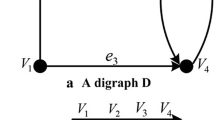Abstract
When using graph theory for kinematic structure enumeration, the isomorphism identification of graphs is an important and complicated problem. The problem is known to be an NP-complete problem. This paper presents a mixed algorithm based on a mapping property, a genetic algorithm, and a simulated annealing algorithm for the isomorphism identification problem. A validity encoding scheme was developed by considering the mapping relationship between two graphs, and some reset measures for the crossover and mutation operators were developed based on the characteristics in which the encoding cell could not be reiterated. A simulated annealing algorithm was introduced into the mixed algorithm to prevent premature convergence in resolution, and some other measures were developed for improving the efficiency, based on the parameter selection. An example shows that the mixed algorithm is a valid algorithm for the isomorphism identification of kinematic structure graphs in mechanism design. It will be a reliable isomorphism identification algorithm for intelligent computer-aided design (CAD) and manufacturing (CAM).
Similar content being viewed by others
Abbreviations
- V(G):
-
The vertex set of graph G
- E(G):
-
The line set of graph G
- σ :
-
One-to-one mapping function
- u, v :
-
Elements of V(G)
- f :
-
Fitness function
- y :
-
Objective function
- c max :
-
The artificial maximum value of y
- \( f\prime _{a} \) :
-
The fitness function value at the current solution
- \( f\prime _{b} \) :
-
The fitness function value at the new solution
- t 0 :
-
Initial temperature in simulated annealing process
- t :
-
Temperature in simulated annealing process
- a :
-
Parameter for deciding t
- g :
-
Generation number
- p k :
-
The probabilistic rate from old individual to new individual by introducing the simulated annealing algorithm
References
Tsai LW (2001) Mechanism design: enumeration of kinematic structures according to function. CRC Press, Boca Raton, Florida
Hsu Cheng-Ho (2002) An analytic methodology for the kinematic synthesis of epicyclic gear mechanisms. J Mech Des—Trans ASME 124(3):574–576
Chen L (2000) A selected tour of the theory of identification matrices. Theor Comp Sci 240(2):299–318
Rao AC (2003) A genetic algorithm for epicyclic gear trains. Mech Mach Theory 38(2):135–147
Hart RPS, Larcombe MT, Sherlock RA, Smith LA (1998) Optimisation techniques for a computer simulation of a pastoral dairy farm. Comput Electron Agric 19(2):129–153
Bruzzone A, Signorile R (1998) Simulation and genetic algorithms for ship planning and shipyard layout. Simulation 71(2):74–83
McHaney R (1999) Integration of the genetic algorithm and discrete-event computer simulation for decision support. Simulation 72(6):401–411
Acknowledgements
The authors would like to acknowledge the support of the National Natural Science Foundation of China, the Natural Science Foundation of Guangxi Province of China, the Natural Science Foundation for Qualified Personnel of JiangSu University, and the support program for Young and Middle-aged Disciplinary Leaders at the Guangxi Higher Education Institution, and Innovative Science Foundation of Jiangsu University during the course of this work.
Author information
Authors and Affiliations
Corresponding author
Rights and permissions
About this article
Cite this article
Ping, Y., NingBo, L., Bin, Y. et al. A mixed isomorphism approach for kinematic structure enumeration graphs based on intelligent design and manufacturing. Int J Adv Manuf Technol 31, 841–845 (2007). https://doi.org/10.1007/s00170-005-0263-y
Received:
Accepted:
Published:
Issue Date:
DOI: https://doi.org/10.1007/s00170-005-0263-y




